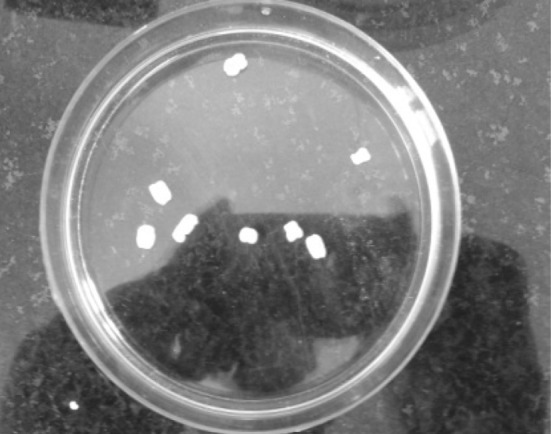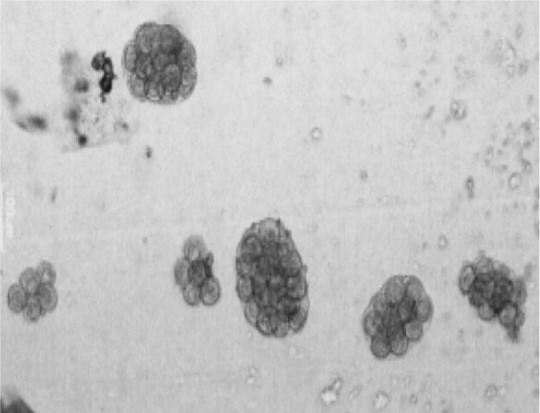Abstract
The present study is related to Dipylidium caninum infection in dogs. Three dogs about 1 year of age with the history of scooting behaviour and passing diarrhoeic stool containing white specks were presented before the clinicians. Physical examination of dogs revealed flea infestation and faecal examination revealed the presence of gravid segments, which were confirmed microscopically to be of cestode, D. caninum. Dogs were treated with Praziquantel@5 mg/kg body wt. orally. Dogs showed marked recovery post treatment. On re-examination after a week, faeces were found negative for any parasitic eggs/gravid segments.
Keywords: Dog, Dipylidium caninum, Gravid segments, Dog flea
Introduction
Dipylidium caninum commonly known as dog tapeworm is worldwide in distribution. D. caninum mostly affects dogs and cats but it can also cause infection in human beings (Taylor et al. 2007). It is mainly transmitted by fleas, Ctenocephalides canis, C. felis and Pulex irritans and also by dog biting louse, Trichodectes canis. Dogs get infection by accidently ingesting infected flea or lice (Soulsby 1982). Dogs infected with D. caninum shed proglottids in their faeces and these proglottids containing eggs in the environment are consumed by flea larvae (Yasuda et al. 1971). This parasite is not very harmful in adult dogs, though at point of attachment there may be haemorrhage leading to enteritis and diarrhoea. It is clinically manifested as retarded growth rate, reduced working capacity and general ill health (Soulsby 1982). Humans are accidentally infected when they swallow dog flea harbouring tapeworm metacestode stage, cysticercoid. D. caninum infections are reported mostly in children (Ramana et al. 2011; Narasimham et al. 2013). Pruritus is caused when gravid segments pass through the anus of infected host. Dipylidium infections can be successfully treated in humans and animals. The present communication deals with the diagnosis and successful management of dipylidiosis in three dogs.
Materials and methods
Clinical history
Three German Shepherd dogs about 1 year of age were presented to Referral Veterinary Polyclinic, IVRI, Izatnagar, Bareilly (U.P) with the history of dullness, diarrhoeic faeces, white specks/segments in faeces and scooting behaviour. Dogs were dewormed quarterly with pyrantel pamoate. There was no history of fever or vomiting. Dogs were provided with good diet but still unthriftiness and poor hair coat was observed.
Clinical examination
Dogs were found to have normal pink conjunctiva and temperature of 101.9°F. No pain was evinced on abdominal palpation. Fleas were found on their hair coat. With lubricated gloved hands, anal sacs were palpated to rule out anal sacculitis as cause of scooting behaviour and found to be healthy. Faecal examination showed presence of gravid segments of some tapeworm and hence the samples were sent to Division of Parasitology, IVRI for confirmation of infection and identification of tapeworm spp. involved.
Parasitological examination
Direct faecal examination revealed the presence of cestode gravid segments. Gravid segments were separated from faeces and kept in normal saline solution (Fig. 1). Under the stereoscope, gravid segments were found to have cucumber seed shape. A gravid segment when pressed between two slides and stretched showed the presence of egg capsules containing eggs. High power magnification showed the presence of egg capsule containing 8–16 eggs (Figs. 2, 3).
Fig. 1.

Gravid segments from faeces
Fig. 2.

Dipylidium caninum egg capsules (×100)
Fig. 3.

Dipylidium caninum single egg capsule (×400)
Treatment
Dogs were confirmed to be suffering from Dipylidium caninum infection. Hence, successfully treated with Praziquantel@5 mg/kg body wt. orally. All the three dogs showed marked recovery when re-examined after a week.
Result and discussion
Dogs were confirmed to be suffering from Dipylidium caninum infection. The gravid segments were processed as per standard protocol (Soulsby 1982). After preparation of permanent mounts, the specimens were identified based on morphological criteria as described by Soulsby (1982). Presence of egg capsules containing up to 30 eggs is the characteristic feature of D. caninum. Major reason for increasing trend of Dipylidium cases is lack of knowledge regarding deworming schedule and choice of anthelmintics. Scooting behaviour seen in infected dogs is due to anal pruritis caused by motile gravid segments passing through their anus. Careful and strict deworming schedule along with ectoparasite control is the only solid remedy for current situation. Occurrence of D. caninum infection in dogs has been reported by several authors (Sahai 1969; Kumar and Sahai 1972; Deka and Choudhary 1994). Presence of fleas in the surrounding relates to the occurrence of tapeworm infection in dogs, as these fleas act as intermediate hosts for D. caninum.
References
- Deka DK, Choudhary S. Incidence of helminth infection in dogs in Lakhimpur district of Assam. J Assam Vet Counc. 1994;4:58–59. [Google Scholar]
- Kumar GM, Sahai BN. A note on the incidence of helminth infections in dogs at Patna, Bihar. Indian Vet J. 1972;49:79–82. [Google Scholar]
- Narasimham MV, Panda P, Mohanty I, Sahu S, Padhi S, Dash M. Dipylidium caninum infection in a child: a rare case report. Indian J Med Microbiol. 2013;31(1):82–84. doi: 10.4103/0255-0857.108738. [DOI] [PubMed] [Google Scholar]
- Ramana KV, Rao SD, Rao R, Mohanty SK, Wilson CG. Human dipylidiasis: a case report of Dipylidium caninum infection from Karimnagar. Online J Health Allied Sci. 2011;10(2):28. [Google Scholar]
- Sahai BN. A survey of the helminth parasites of stray dogs in and around Bareilly, Uttar Pradesh. Indian Vet J. 1969;49:734. [PubMed] [Google Scholar]
- Soulsby EJL. Helminths, arthropods and protozoa of domesticated animals. 7. London: Bailliere Tindall; 1982. pp. 763–766. [Google Scholar]
- Taylor MA, Coop RL, Wall RL. Veterinary parasitology. 3. Oxford: Wiley-Blackwell; 2007. pp. 373–375. [Google Scholar]
- Yasuda F, Hashiguchi J, Nishikawa H, Watanabe S. Studies on the life history of Dipylidium caninum (Linnaeus 1758) Bull Nippon Vet Zootech Coll. 1971;17:27–32. [Google Scholar]


